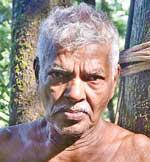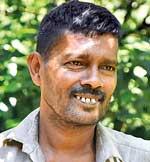Sri Lanka’s Kithul Industry Is Ailing, But Authorities Have Other Plans

Kithul tappers have been depending on trees growing in forest areas to increase the quantity of sap collected
Pics by Kithsiri De Mel
K. Jayaratne (74) from Molkawa, a scenic village in the Bulathsinghala Divisional Secretariat has been a kithul tapper since the tender age of 12. Having been a lucrative occupation at the time, many adults in the village earned a living from this industry. “It was a time when the government assisted us by planting kithul trees in available state lands,” Jayaratne reminisced. “So we earned a good income. Even now we have a favourable income but the rainy season makes it difficult for us to climb the trees,” he added.
tapper since the tender age of 12. Having been a lucrative occupation at the time, many adults in the village earned a living from this industry. “It was a time when the government assisted us by planting kithul trees in available state lands,” Jayaratne reminisced. “So we earned a good income. Even now we have a favourable income but the rainy season makes it difficult for us to climb the trees,” he added.
Kithul-peni or the syrup is used in various cuisines including kiri peni, a traditional Sri Lankan dessert. It boasts of woody, floral, smoky and savoury notes and when boiled further, it sets into molds in the form of jaggery. However, today, original kithul-peni is a vanishing treasure as people are now in the habit of adulterating kithul syrup, and as a result the quality of the syrup has suffered.
Kithul trees were found in abundance in Sri Lanka’s rainforests including Sinharaja but kithul tappers were long been restricted to utilize these areas. Some of the earliest accounts regarding kithul trees were written by 19th century historians. As more trees were felled and rainforests were destroyed to make space for tea and rubber plantations, it threatened the survival of kithul trees. Today, even in areas such as Molkawa and Bulathsinghala that once had a thriving kithul industry, not many trees are seen by the roadside.
Jayaratne owns around 50 kithul trees on his own land. “Once the flowering period is over there is no use of the kithul tree,” he said while pointing at the dead trees. “When a flower is being made, we can draw the sap for around 5-6 months. Toddy is a byproduct which is in high demand but we will be put behind bars if we’re caught selling toddy as it is illegal,” he chuckled.

Tools used to tap kithul
A High Risk Occupation
Despite restrictions, kithul tappers tapped kithul from trees in the jungles. However, the government recently announced that kithul tappers will be allowed to use conservation areas to improve the quantity of sap collected for their industry.
“Perhaps lifting these restrictions will do more harm than good,” said Sunil Shantha, another kithul tapper from Bogahahena. “People are engaged in the moonshine business and they do that inside the forest areas. Despite lifting restrictions we have other concerns that need to be addressed first,” he said.
Over the years, at least 25 kithul tappers have succumbed to injuries while being engaged in tapping kithul. “We don’t have a safety belt and instead make a belt out of creepers. The belt is required to suspend ourselves from the tree as we use both hands to tap the flower and extract the sap. The risk with creepers is that they could be damaged easily and is often subject to wear and tear,” Shantha added.
Sans any kind of personal protective equipment, kithul tappers have been engaged in a high risk and high

K Jayarathne |

Sunil Shantha |
investment proposition that takes time to yield returns. The kithul palm tree would take up to 15 years of constant care for the palm to flower and produce sap. It is also sensitive to changes in wind and rain.
Climate change has greatly impacted seasonal weather patterns over the years and kithul tappers are observing this change in agony. “With heavy rains the quality of the sap extracted from the flower will be impacted,” explained Shantha. “During the past few days it rained to the point that all these areas were flooded. The sap is of high quality when extracted from trees grown in an arid environment.”
He further complained of how they have been ignored by the authorities and the government. “There were certain equipment provided by the authorities but sadly these equipment were given to people who had no connection to the industry. As a result these people have sold these items including safety belts and pans on which the jaggery is being made. The Grama Sevaka in the area hasn’t done any kind of census to find out how many people thrive from this industry. In this backdrop how can we think of a better future for ourselves and the future generations to come?” He questioned.
The fact that the younger generation has been encouraged to look for jobs in the city justifies his statement.






